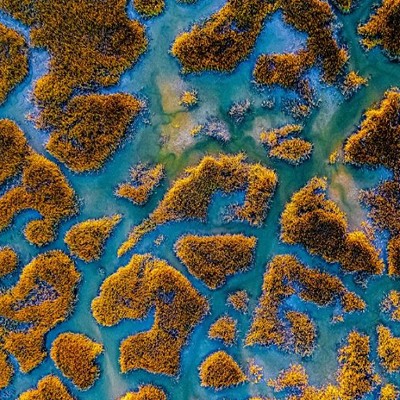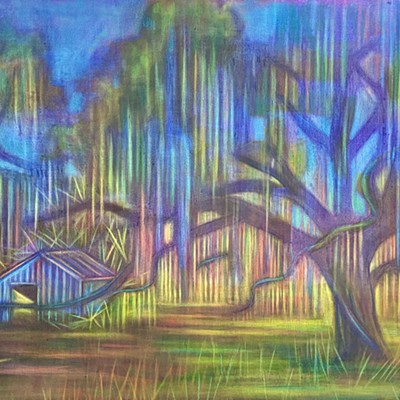An evening rainstorm did little to inhibit supporters of the ever-rising Savannah art scene to come out to the Non-Fiction Gallery on Friday night to view Lollipop, an exhibition by neo-avante garde artist Alexandro Santana, closing Sept. 18.
The artist is no stranger to the world of art, with past exhibitions in Georgia, across the United States and abroad. A painter, an architect and a portraitist, Santana has made a home in Savannah where he is pursuing his MFA in painting at the Savannah College of Art and Design.
Having the pleasure of encountering the artist long before his art, I arrived at the gallery with preconceived notions of his work. It came as no surprise that Alexandro the thinker and the articulator of complex thoughts is also Alexandro the creator of works that reveal the artist's uninhibited passions and desires.
At first glance brilliant color fills the space. Upon closer inspection color gives way to texture, texture gives way to form, and form gives way to words that are painted, written, or pasted onto the paper. These words ask the viewer to linger a moment longer in order to absorb each figurative painting in which the phallic nature of the image surfaces.
Santana enters in the subdued attire of jeans and a dark buttoned down shirt. His hair is cropped and he wears the pensive smile of someone that has done this before. He holds those that he speaks to close, as if sharing the secrets of the world, secrets that are also unveiled in the colorful landscapes of his paintings.
He confides; "Just as the uncertainty of our lives today leaves us open to the unexplainable this new series of paintings allows the material and the meaning of each piece to float and meander amid the ambiguity of our desires."
In the exhibition Lollipop there is an intimacy in his work that allows the viewer to experience the human body through abstraction. Following the sequence of work around the room the forms become incomplete bodies telling unfinished stories. After viewing the last of thirty-six works the artist's concern with the Freudian concept of nachtraglichkeit, or afterwardness, emerges. Demanding both reflection of the work and introspection, Lollipop is the feverish output of a man who unhesitatingly explores the ambiguity of sexuality through painting.
Santana's chosen medium for this body of work is oil on wax paper. Matted within a white and slate frame, these paintings are intimate encounters with figurative abstractions and confrontations with our own sensuality. For the artist, the paints reaction to wax paper gives birth to the notion of skin and skin is present in all but one painting in the gallery.
The presence of sexuality in Santana's work is found in the subtle articulations of the male form. A tip of a penis, the outline of a scrotum, the imprint of an anus; the stereotypical strength associated with these male features are delivered with the delicacy of a man comfortable with the uncomfortable, certain in his uncertainty and clear in his ambiguity.
Santana's work strips the violence from our associations with sexuality, particularly homosexuality. The shape of a penis here, the form of an anus there are not something to be embraced, not feared.
The delicate colors that he uses are feminine, yet the forms are distinctly masculine thus the works become both phallic and yonic, exuding sensuous beauty with every brushstroke. It is evident that Santana does not execute these paintings from a position of power but of vulnerability. and they are all indications of the artist's experience with the unforeseen and the unknown.
Fellow MFA candidate Rachel Pendergrass notes, "True art is when you can turn pain and ecstasy into beauty on the page." Alexandro Santana's art does just that.
Although the pieces are aptly titled Shaven Peep, Dildo-Lolli, and even Bent Cock, the body of work is non-confrontational, and a subtle sensuality arises from the artist's delicate use of pinks, yellows, and blues. They are the colors of spring, of promise, and of hope. As our nation struggles with gay rights, these paintings demonstrate that love is not only universal, it is also beautiful. Thirty percent of the proceeds from work sold will be donated by Alexandro Santana to Design Industries Foundation Fighting AIDS.
In viewing these paintings one is uncertain whether love has been lost or found. On my way out, the artist informs me that it is just love, or at least the way that love should look like.
Taking one last look at his paintings I think to myself, "Yes, Alexandro, love does look like that."
Above, artist Alexandro Santana with art lover Bobbi Perry at a previous show around town. At left, Santana's work at Non-Fiction Gallery

























